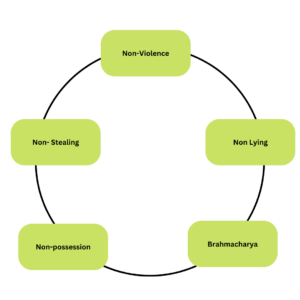Introduction
One of the world’s most peaceful religions is Jainism, which originated in India. The Jain religion is well known for its strong dedication to non-violence and refraining from injuring any living thing. The word “Ji,” which means to conquer in ancient Sanskrit, is where Jainism got its start. According to Jain monks, enlightenment cannot be attained without letting go of all earthly passions and wants. People who achieve enlightenment become referred to as “Jina.” Between 500 and 600 BCE, in the Gangetic Plains, Jainism was born. It belonged to one of the numerous religious movements that emerged during that period. For Jains, enlightenment and breaking free from the cycle of life and death are the main goals.

Origin of Jainism
It is quite challenging to pinpoint the precise roots of Jainism. Rishabhnath is the first Tirthankara of Jainism, but it only gained popularity and became a fully recognized religion during the reign of Mahavir. The 24th Tirthankara of the Jains, Vardhman Mahavir, lived during the lifetime of Gautam Buddha. The Buddha was born into the Kshatriya family in a village close to Vaishali, Bihar. His mother Trishla was the sister of the Lichhavi monarch Chetak, while his father Siddhartha was the head of the Kshatriya tribe.
At the age of 30, Mahavir left the family to look for the truth. He gave up all passion and desire, followed the austere path of solitude and meditation, and became an ascetic for 12 years. After the tribulation of 12 years, he acquired Kaivalya, which signifies omniscience. He has conquered both bliss and suffering. He travelled with his followers for the next 30 years, spreading the teachings of the Jain religion.
Causes of the rise of Jainism:
Brahman, Kshatriya, Vaisya, and Sudra were the four Varna. The hierarchy of society placed the Brahmans as the most powerful and pre-eminent Varna. They were given priestly responsibilities. The main causes of the rise of Jainism are as follows:
- The Kshatriya Varna’s resistance to Brahmanical rule was one of the primary factors.
- The increasing ritualistic dominance of Brahman infuriated other Varna as well.
- Another element in the birth of the new religion was corruption inside pre-existing religions.
- People’s discontent was also greatly influenced by language because Brahmans spoke Sanskrit, a language that the general populace did not know.
Teachings of Jainism
The non-violent Ahimsa principle is central to Jainism. They hold that the sole path to moksha, or unending emancipation, is through the soul’s purification. There are five doctrines of Jainism:
- Non-violence
- Do not lie
- Do not steal
- Do not stock unnecessarily
- Observe brahmacharya
Every Jain is required to adhere to these five precepts. Mahavira advised his disciples to live a rigorous life and even give up wearing clothing. In Jainism, three Triratnas can be used to achieve ultimate liberation. These are:
- Through the right knowledge
- Through right faith
- Through right action

- The first level discusses the elements that make up the universe:
- The universe’s living soul is known as Jiva.
- The world’s non-living substance is ajiva.
- The universe’s behaviours are described in the second stage.
- Punya is a noble action.
- Papa, that was a poor act.
- Karma in the universe is discussed in the third level.
- Through yoga and meditation, Asrava describes the influx of karma into the soul.
- Samvara is the halting of material karma from entering the soul.
- Simply said, bandha refers to the relationship between karma and the soul.
- The final stage before achieving eternal liberty is called Nirjara. Nirjara is the act of giving up karma altogether. If someone wants to achieve moksha, they must give up their past deeds and refrain from creating new ones.
- Complete soul emancipation and achieving moksha are the last stages. The end of the birth-and-death cycle.
Split in Jainism
About 200 years after Mahavir’s passing, north India was devastated by a severe famine. Twelve years passed during the severe famine. In search of better living conditions, people began to move. Many Jainas immigrated to south India with other individuals. Numerous pieces of evidence demonstrate how Jainism expanded throughout Karnataka at this time. The migrant Jainas insisted that they fully adhered to Jainism’s principles and teachings and that they never violated any vows. They stopped wearing garments and started being called Digambaras.
When the hunger was over, Digambaras returned to Magadha. They asserted that local Jainas had been distorted and that Jainas who had never left Magadha had broken the law and broken their vows. They were called Shvetambaras and wore white clothing. Jainism was split into the Digambara and Svetambara factions.
Facts about Jainism:
- In Jainism, there are no priests. There are solely nuns and monks there.
- Like Buddhism, Jainism did not criticise the Varna system.
- Jainism did not initially engage in idol worship or any other form of image worship.
- The use of Prakrit gained popularity thanks to Jainism.
- Jains always place a piece of cloth in front of their mouths to prevent unintentional organism inhalation.
Summary
The Jain religion is well known for its strong dedication to non-violence and refraining from injuring any living thing. Rishabhnath is the first Tirthankara of Jainism, but it only gained popularity and became a fully recognized religion during the reign of Mahavir. The non-violent Ahimsa principle is central to Jainism. Jainism did not initially engage in idol worship or any other form of image worship.
Frequently Asked Questions (FAQs)
1.What was the main reason for Fewer Followers of Jainism?
Ans. The rigorous and stringent restrictions that had to be followed were one of many reasons why Jainism had fewer adherents. For instance, becoming a vegetarian and giving up all ties to the world, including family and clothing. Jainism also advises against farming since it can harm species that live underground.
2.How did Jainism spread in India?
Ans. To spread their religion, the various Jain sects split up and dispersed throughout India. Many caves and Jaina pilgrimage sites were constructed by Jaina kings. Jainism was also welcomed by the local populace because it had no caste system.
3.What are Agamas?
Ans. Jain Agamas are religious texts or literary works of Jainism. The number of Jain Agamas is 46. A Jain agama is a revelation from a Tirthankara.
4.What is the core belief of Jainism?
Ans. As far as possible, Jainism believes that to reach enlightenment, non-violence must be practised and harm to living beings reduced. Jains also believe in reincarnation, just like Hindus and Buddhists. Moreover, they believed that karma was responsible for this birth, rebirth, and death cycle.
5.How did Jainas migrate to South India?
Ans. It was predicted by Acharya Bhadrabahu that north India would suffer a twelve-year famine, so the Jain sangha migrated south. The Sangha stopped at Chandragiri Hill with his disciple Chandragupta Maurya.